Navigation
Encyclopedia Of Life (EOL) Species Pages Now Available
- Alfred P. Sloan Foundation
- biodiversity
- Biodiversity Heritage Library (BHL)
- Citizen scientists
- conservation
- education
- Encyclopedia Of Life (EOL)
- fish
- John D. and Catherine T. MacArthur Foundation
- mammals
- Marine Biological Laboratory
- natural history
- preservation
- Smithsonian Institution
- species
- Woods Hole
- Biodiversity
An international group of scientists, research institutions and museums is currently working to assemble the most comprehensive online biodiversity encyclopedia on the planet.
Do you know what a Sphyrna zygaena is? How many pounds of krill does a blue whale consume each day? What plants are endangered in Italy?
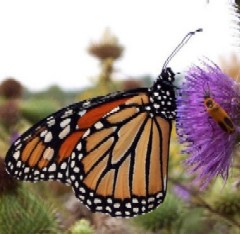 |
| Monarch Butterfly Photo by Bruce Marlin |
How are monarch butterflies affected by climate change in northern California?
Now with the click of a button you will be able to access this kind of information on all the world’s plants, animals and microorganisms.
An international group of scientists, research institutions and museums is currently working to assemble the most comprehensive online biodiversity encyclopedia on the planet.
This project is called the Encyclopedia of Life (EOL) and it was launched in May of 2007.
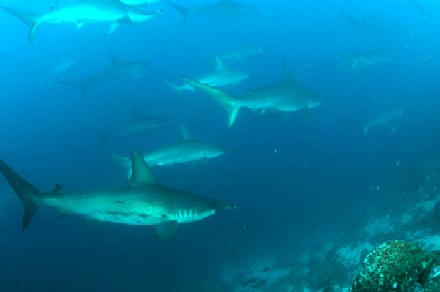 |
| Hammerhead Shark Photo: Aquaimages |
The EOL will help educate the world’s citizens about biodiversity and promote a sense of awareness for our natural surroundings. It will also accelerate the discovery of new species as well as the cataloguing of biodiversity.
According to Graham Higley, head of Library & Information Services at the Natural History Museum in London, “On a planet of shrinking resources, this information will help people make wiser decisions about preserving our natural world.”
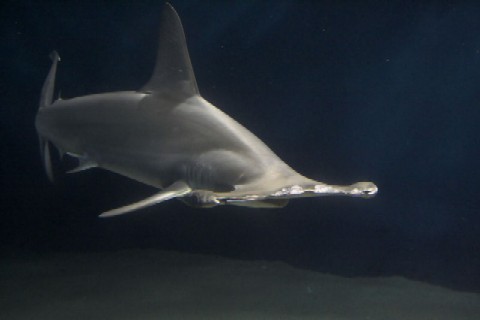 |
| Hammerhead Shark Photo by Suneko |
Demand for biodiversity information by the scientific community, naturalists, conservationists, educators and the public is growing. In recent years the scientific community has recognized its responsibility for making accurate biodiversity information more accessible and, at the same time, technology has advanced to the point where this knowledge can be linked together and made available in an efficient and cost-effective way. The time for the EOL is now.
A project of this scope and magnitude has never been executed before. The EOL is a dynamic Web environment that will provide access to information on each of the approximately 1.8 million species now known to be present on Earth.
A configurable entry page allows users to adjust the site to their individual preferences. The EOL functions like a good field guide, but one that is easier to navigate, because information is instantly at your fingertips and can be organized to include exactly what you want to see.
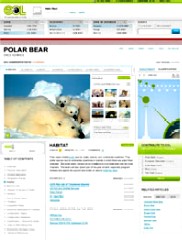 |
For example, each page presents such facts as the scientific and common names of the species (in several languages), photos and illustrations, habitat and natural history information, conservation status and human uses, and keys for how to identify the species. All this data is being verified by scientific experts, providing the user an authoritative set of information.
From the entry page, users are able to jump to a wide variety of more specialized pages, including ones for molecular biologists, horticulturalists, students and teachers, and the general public, just to name a few. Biodiversity literature will be available, too, through the EOL’s partnership with the Biodiversity Heritage Library (BHL) consortium.
The BHL consortium is made up of ten major natural history museum libraries, botanical libraries, and research institutions from around the world that have joined forces in an effort to digitize all of the published biodiversity literature held in each of their respective collections. As part of the EOL, the BHL will digitally scan millions of pages of the world’s biodiversity literature to make old and rare documents freely available to everyone on the Internet. To date, more than two million pages of literature have been scanned, and a new scanning center recently debuted in Boston. BHL has a small center operational at the Smithsonian (one scanner), one at Natural History Museum London (one scanner), and two scanners are running at the University of Illinois (Urbana-Champaign) doing Field Museum titles.
The Encyclopedia of Life’s core activities are led by five working groups: Species Sites, Biodiversity Informatics, Scanning and Digitization, Biodiversity Synthesis, and Education and Outreach. Each team works from their home site at different research institutions or museums around the country to further their group goals for the EOL.
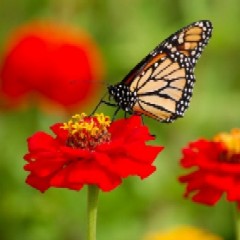 |
| Monarch Butterfly Photo by Simon Koopmann |
The Species Sites group, based at the National Museum of Natural History, Smithsonian Institution, Washington, DC, works with the scientific community to develop entry-level species pages for all the 1.8 million known and named species. These species pages are at the heart of the EOL. Each site consists of an entry level page, designed for the general public, and more specialized resources for particular audiences. This group also recruits experts from the scientific community to act as ‘curators’ to ensure that the information on each page is up-to-date and correct.
The Biodiversity Informatics group, housed at the Marine Biological Laboratory, Woods Hole, Massachusetts, is developing the software to seamlessly move data into the species pages. Unique tools will help the team capture, organize, and reshape knowledge of biodiversity. Visitors can use advanced search capabilities and have the ability to personalize the Encyclopedia pages based on the information they seek.
The Scanning and Digitization group works closely with the BHL consortium to ensure on-line access to the contents of many of the world’s preeminent scientific documents and literature. These efforts will allow anyone, anywhere to read, search, and download scientific articles that were previously unavailable to them. The digitized literature will be especially valuable to individuals in developing countries who do not have access to comprehensive libraries.
The Biodiversity Synthesis group works from their base at the Field Museum of Natural History to develop tools and procedures for searching across and mining information from large numbers of species pages to synthesize new knowledge about biodiversity and the evolution of life. The group will also forge links among diverse communities of researchers and users to demonstrate how the EOL can be a tool for improved conservation of the planet.
The Education and Outreach group, based at the Harvard Museum of Natural History and in coordination with the Smithsonian Institution, seeks to take advantage of the EOL by exploring and promoting its educational uses in schools and universities. They will also collaborate with ‘informal education’ groups such as natural history museums and nature centers to show how the Encyclopedia can extend learning beyond classroom walls.
Other institutions from across the United States and around the world have been invited as collaborators, and links have already been established with many efforts already underway. Some participating groups include Global Biodiversity Information Facility (GBIF), FishBase, Tree of Life Web, Catalogue of Life, and AmphibiaWeb.
The cost for the first five-year phase of the EOL is estimated to be approximately $50 million and part of this has been funded by grants from The John D. and Catherine T. MacArthur Foundation and the Alfred P. Sloan Foundation.
With initial funding in place, we are hard at work on all facets of the EOL. The first 30,000 authenticated species pages are now available. Within five years, the EOL aims to create one million species pages, each one of which will be verified by scientific experts.
Citizen scientists of all ages are able to participate in the creation and growth of the EOL by contributing species information, such as photos, observations, comments, or species data, from their own back yards or from community- or school-based “bioblitzes” (organized biodiversity census events).
Elizabeth Werby of the Education and Outreach group explains, “Many citizen science groups are already engaged in similar activities—from counts focused on certain groups, such as Cornell Laboratory of Ornithology’s eBird to counts focused on defined areas, such as the Central Park Bioblitz in 2006. We can learn from and build on these activities to foster interest and enthusiasm in biodiversity.”
You may also join the EOL forum where you can post questions or participate in discussions about various aspects of the EOL.
On the technology front, the Biodiversity Informatics group hopes to configure the EOL for handheld devices within the next five years. This means that anybody, anywhere in the world can to photograph a plant or animal, upload it to the site, and instantly download the species information. It alsos enables scientists in the field to quickly and efficiently identify new species and post this information on the EOL database.
Each day the EOL makes progress in creating a website that will transform the way we see the world around us. And as we build the Encyclopedia of Life, we look forward to sharing its limitless potential with you.
For more information, please visit the following websites:
Biodiversity Heritage Library consortium
This is an updated version of the article written for Horizon International’s Horizon Solutions Site by Breen Byrnes, Public Information Officer, Encyclopedia of Life Secretariat on November 7, 2007.
Contact:
Breen Byrnes
Public Information Officer
Encyclopedia of Life
Smithsonian Institution
(202) 633-8730
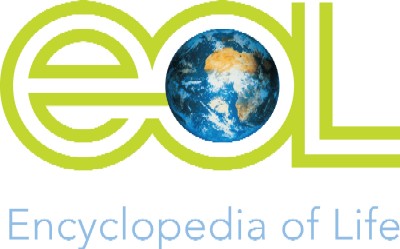 |
Search
Latest articles
Agriculture
- World Water Week: Healthy ecosystems essential to human health: from coronavirus to malnutrition Online session Wednesday 24 August 17:00-18:20
- World Water Week: Healthy ecosystems essential to human health: from coronavirus to malnutrition Online session Wednesday 24 August 17:00-18:20
Air Pollution
- "Water and Sanitation-Related Diseases and the Changing Environment: Challenges, Interventions, and Preventive Measures" Volume 2 Is Now Available
- Global Innovation Exchange Co-Created by Horizon International, USAID, Bill and Melinda Gates Foundation and Others
Biodiversity
- It is time for international mobilization against climate change
- World Water Week: Healthy ecosystems essential to human health: from coronavirus to malnutrition Online session Wednesday 24 August 17:00-18:20
Desertification
- World Water Week: Healthy ecosystems essential to human health: from coronavirus to malnutrition Online session Wednesday 24 August 17:00-18:20
- UN Food Systems Summit Receives Over 1,200 Ideas to Help Meet Sustainable Development Goals
Endangered Species
- Mangrove Action Project Collaborates to Restore and Preserve Mangrove Ecosystems
- Coral Research in Palau offers a “Glimmer of Hope”
Energy
- Global Innovation Exchange Co-Created by Horizon International, USAID, Bill and Melinda Gates Foundation and Others
- Wildlife Preservation in Southeast Nova Scotia
Exhibits
- Global Innovation Exchange Co-Created by Horizon International, USAID, Bill and Melinda Gates Foundation and Others
- Coral Reefs
Forests
- NASA Satellites Reveal Major Shifts in Global Freshwater Updated June 2020
- Global Innovation Exchange Co-Created by Horizon International, USAID, Bill and Melinda Gates Foundation and Others
Global Climate Change
- It is time for international mobilization against climate change
- It is time for international mobilization against climate change
Global Health
- World Water Week: Healthy ecosystems essential to human health: from coronavirus to malnutrition Online session Wednesday 24 August 17:00-18:20
- More than 400 schoolgirls, family and teachers rescued from Afghanistan by small coalition
Industry
- "Water and Sanitation-Related Diseases and the Changing Environment: Challenges, Interventions, and Preventive Measures" Volume 2 Is Now Available
- Global Innovation Exchange Co-Created by Horizon International, USAID, Bill and Melinda Gates Foundation and Others
Natural Disaster Relief
- STOP ATTACKS ON HEALTH CARE IN UKRAINE
- Global Innovation Exchange Co-Created by Horizon International, USAID, Bill and Melinda Gates Foundation and Others
News and Special Reports
- World Water Week: Healthy ecosystems essential to human health: from coronavirus to malnutrition Online session Wednesday 24 August 17:00-18:20
- STOP ATTACKS ON HEALTH CARE IN UKRAINE
Oceans, Coral Reefs
- World Water Week: Healthy ecosystems essential to human health: from coronavirus to malnutrition Online session Wednesday 24 August 17:00-18:20
- Mangrove Action Project Collaborates to Restore and Preserve Mangrove Ecosystems
Pollution
- Zakaria Ouedraogo of Burkina Faso Produces Film “Nzoue Fiyen: Water Not Drinkable”
- "Water and Sanitation-Related Diseases and the Changing Environment: Challenges, Interventions, and Preventive Measures" Volume 2 Is Now Available
Population
- "Water and Sanitation-Related Diseases and the Changing Environment: Challenges, Interventions, and Preventive Measures" Volume 2 Is Now Available
- "Water and Sanitation-Related Diseases and the Changing Environment: Challenges, Interventions, and Preventive Measures" Volume 2 Is Now Available
Public Health
- Honouring the visionary behind India’s sanitation revolution
- Honouring the visionary behind India’s sanitation revolution
Rivers
- World Water Week: Healthy ecosystems essential to human health: from coronavirus to malnutrition Online session Wednesday 24 August 17:00-18:20
- Mangrove Action Project Collaborates to Restore and Preserve Mangrove Ecosystems
Sanitation
- Honouring the visionary behind India’s sanitation revolution
- Honouring the visionary behind India’s sanitation revolution
Toxic Chemicals
- "Water and Sanitation-Related Diseases and the Changing Environment: Challenges, Interventions, and Preventive Measures" Volume 2 Is Now Available
- Actions to Prevent Polluted Drinking Water in the United States
Transportation
- "Water and Sanitation-Related Diseases and the Changing Environment: Challenges, Interventions, and Preventive Measures" Volume 2 Is Now Available
- Urbanization Provides Opportunities for Transition to a Green Economy, Says New Report
Waste Management
- Honouring the visionary behind India’s sanitation revolution
- Honouring the visionary behind India’s sanitation revolution
Water
- Honouring the visionary behind India’s sanitation revolution
- Honouring the visionary behind India’s sanitation revolution
Water and Sanitation
- Honouring the visionary behind India’s sanitation revolution
- Honouring the visionary behind India’s sanitation revolution

